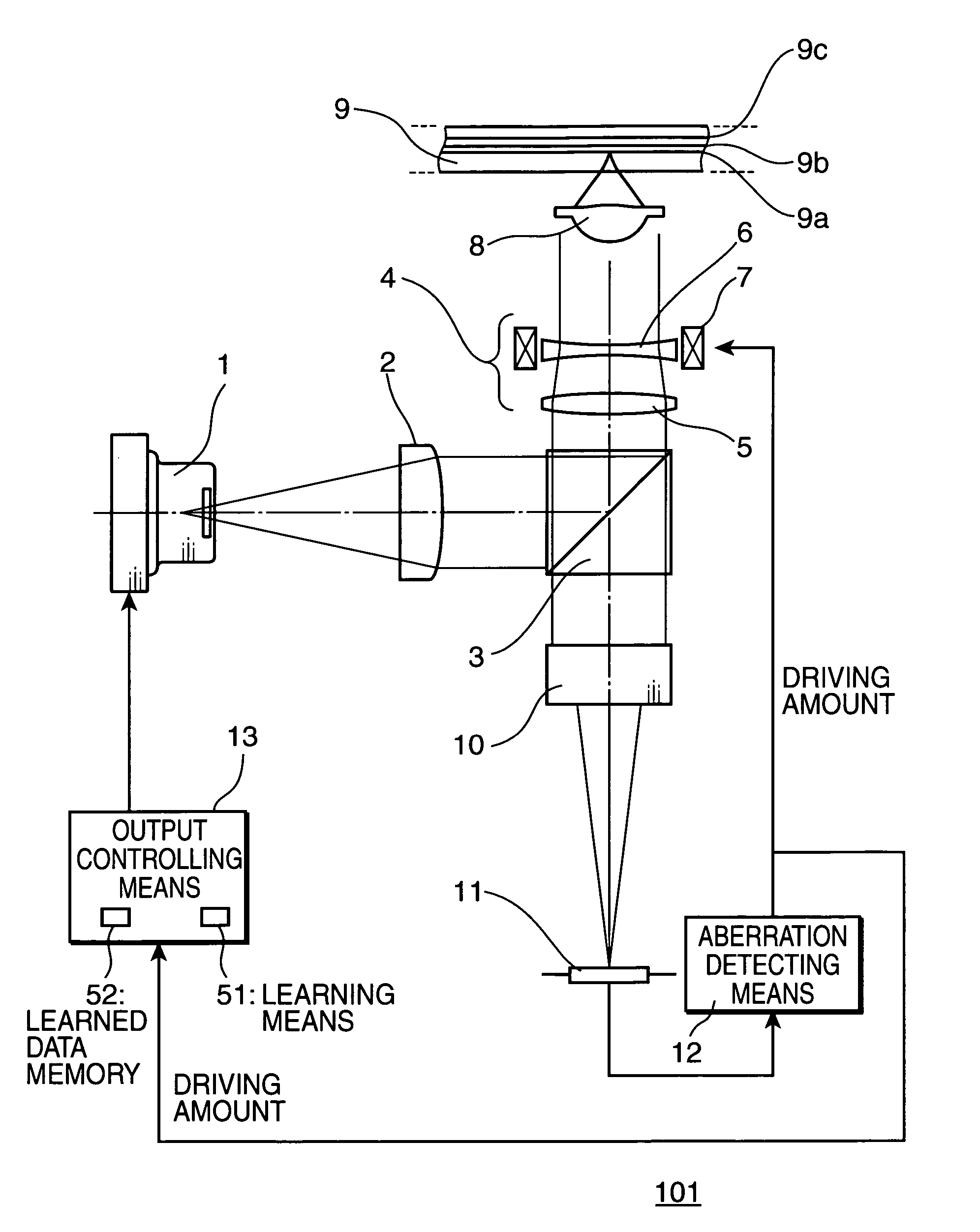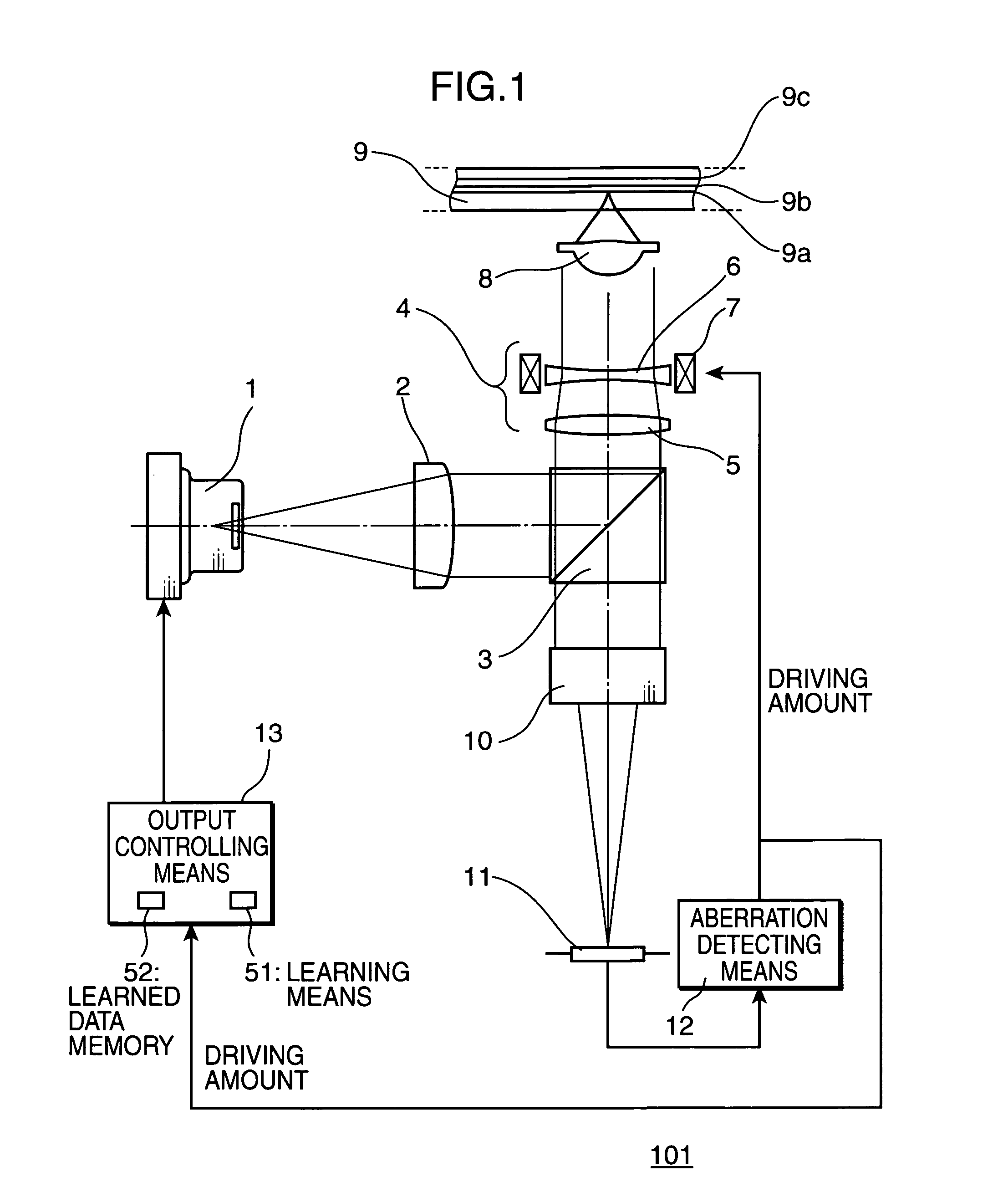Optical head device, optical recording device, and optical recording method
a recording device and optical head technology, applied in the direction of optical beam sources, instruments, disposition/mounting of heads, etc., can solve the problems of degrading data recording characteristics, reducing learning hours, and difficult to arrange a plate member or wedge-like block between the focusing lens and the optical lens. achieve the effect of increasing learning hours and acquiring the optimum recording characteristics of an optical recording
- Summary
- Abstract
- Description
- Claims
- Application Information
AI Technical Summary
Benefits of technology
Problems solved by technology
Method used
Image
Examples
first embodiment
[0025]FIG. 1 is an illustration showing an arrangement of an optical head device in accordance with a first embodiment of the present invention. The optical head device 101 includes a light source 1, a collimator lens 2, a beam splitter 3, wavefront converting means 4, a focusing lens 8, a detection optical system 10, a light detector 11, aberration detecting means 12, and output controlling means 13. The light source 1 is preferably a semiconductor laser which emits laser light of wavelength 405 nm. The collimator lens 2 is adapted to make the laser light emitted from the light source 1 to parallel beams. The beam splitter 3 is adapted to split the optical path of light. The wavefront converting means 4 has a converging lens 5, a diverging lens 6, and driving means 7. The driving means 7 is adapted to drive the diverging lens 6. The driving means 7 is preferably a voice coil motor.
[0026]An optical recording medium 9 from which or in which data is to be read or written with use of t...
second embodiment
[0053]FIG. 9 is an illustration showing an arrangement of an optical head device in accordance with a second embodiment of the present invention. Referring to FIG. 9, elements identical to or equivalent to those in FIG. 1 are denoted by the same reference numerals, and description thereof will be omitted herein. Wavefront converting means 14 shown in FIG. 9 is constructed such that a liquid crystal device 61 is provided between electrodes 62a and 62b. As is well known, the phase of linear polarized light can be changed by applying a voltage to the liquid crystal device. Accordingly, spherical aberration can be corrected by providing well-known coaxially aligned annular electrodes as the electrodes 62a, 62b, and by changing the drive voltage to be applied to each of the annular electrodes. Likewise, as is well known in the art, a coma aberration can be corrected by dividing each of the annular electrodes radially into plural zones. Since the optical head device 102 in accordance with...
third embodiment
[0054]An optical recording device using the inventive optical head device is described as a third embodiment of the present invention referring to FIG. 10. As shown in FIG. 10, the optical recording device 103 includes an optical head device 15, rotation driving means 17, a circuit substrate 18, and a power source 19. The optical head device 15 is the optical head device 101 or the optical head device 101A as the first embodiment, or an optical head device 102 as the second embodiment. The rotation driving means 17 has a motor for drivingly rotating an optical disk 16 as an example of the optical recording medium while supporting the optical disk 16. The optical disk 16 has multiple data layers.
[0055]The optical head device 15 sends, to the circuit substrate 18, a signal indicative of a position thereof relative to the optical disk 16. The circuit substrate 18 computes the signal, and outputs a signal for minutely moving the optical head device 15 or a focusing lens 8 in the optical...
PUM
| Property | Measurement | Unit |
|---|---|---|
| wavelength | aaaaa | aaaaa |
| thickness | aaaaa | aaaaa |
| thickness | aaaaa | aaaaa |
Abstract
Description
Claims
Application Information
 Login to View More
Login to View More - R&D
- Intellectual Property
- Life Sciences
- Materials
- Tech Scout
- Unparalleled Data Quality
- Higher Quality Content
- 60% Fewer Hallucinations
Browse by: Latest US Patents, China's latest patents, Technical Efficacy Thesaurus, Application Domain, Technology Topic, Popular Technical Reports.
© 2025 PatSnap. All rights reserved.Legal|Privacy policy|Modern Slavery Act Transparency Statement|Sitemap|About US| Contact US: help@patsnap.com



